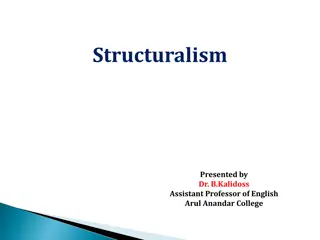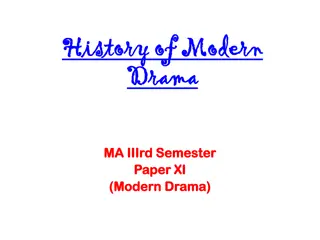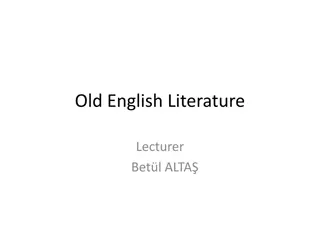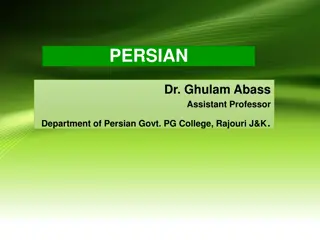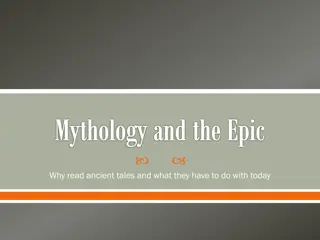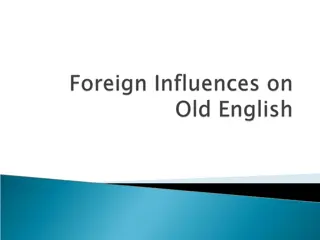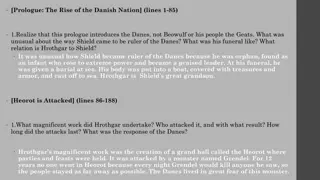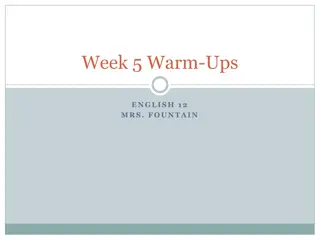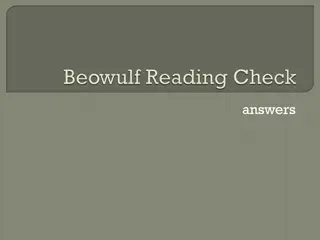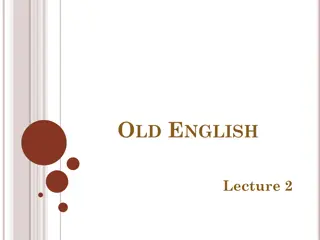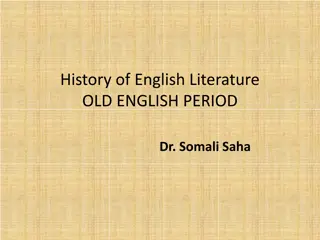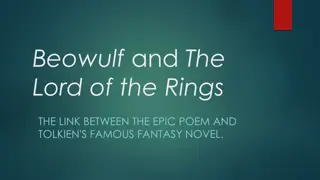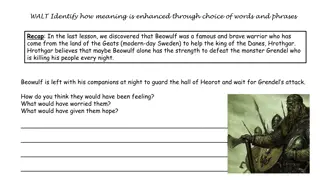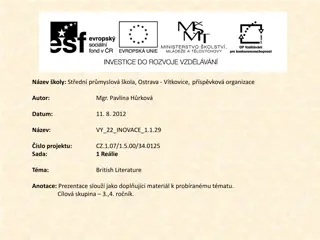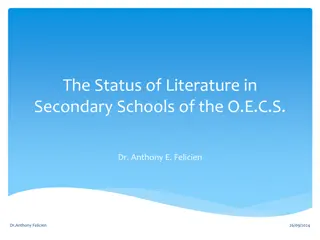Evolution of English Literature: From Old English to Beowulf
The English language, evolving over 1,400 years, transitioned from Old English to Middle English with works like Beowulf standing as a pinnacle of Old English literature. The epic poem tells the tale of Beowulf's heroic feats in pagan Scandinavia, showcasing elements of alliteration, a key literary device. The Norman conquest brought changes, with French becoming prominent, yet Old English works like Beowulf continue to hold significance in literary history.
Download Presentation

Please find below an Image/Link to download the presentation.
The content on the website is provided AS IS for your information and personal use only. It may not be sold, licensed, or shared on other websites without obtaining consent from the author. Download presentation by click this link. If you encounter any issues during the download, it is possible that the publisher has removed the file from their server.
E N D
Presentation Transcript
Topics Old English literature (c. 450 1066) Middle English literature (1066 1500) Medieval theatre English Renaissance (1500 1660) Elizabethan period (1558 1603) Poetry Drama Jacobean period (1603 1625) Drama Poetry Prose Late Renaissance (1625 1660) Poetry 1 2 2.1 3 3.1 3.1.1 3.1.2 3.2 3.2.1 3.2.2 3.2.3 3.3 3.3.1 4 4.1 4.2 4.3 5 5.1 5.1.1 5.1.2 5.1.3 5.2 5.2.1 Restoration Age (1660 1700) Poetry Prose Drama 18th century Augustan literature (1700 1745) Poetry Drama Prose, including the novel Age of Sensibility (1745 1798) Precursors of Romanticism
Introduction The English language has developed over the course of more than 1,400 years. The earliest forms of English, a set of Anglo-Frisian dialects brought to Great Britain by Anglo- Saxon invaders in the fifth century, are called Old English. Beowulf is the most famous work in Old English, and has achieved national epic status in England, despite being set in Scandinavia. However, following the Norman conquest of England in 1066, the written form of the Anglo-Saxon language became less common. Under the influence of the new aristocracy, French became the standard language of courts, parliament, and polite society.
Introduction Beowulf is an Old English epic poem in the tradition of Germanic heroic legend consisting of 3,182 alliterative lines. It is one of the most important and most often translated works of Old English literature. The date of composition is a matter of contention among scholars; the only certain dating is for the manuscript, which was produced between 975 and 1025.
Introduction The story is set in pagan Scandinavia in the 6th century. Beowulf, a hero of the Geats, comes to the aid of Hrothgar, the king of the Danes, whose mead hall in Heorot has been under attack by the monster Grendel. After Beowulf slays him, Grendel's mother attacks the hall and is then defeated. Victorious, Beowulf goes home to Geatland (G taland in modern Sweden) and becomes king of the Geats. Fifty years later, Beowulf defeats a dragon, but is mortally wounded in the battle. After his death, his attendants cremate his body and erect a tower on a headland in his memory.
Introduction In literature, alliteration is the conspicuous repetition of identical initial consonant sounds in successive or closely associated syllables within a group of words, even those spelled differently.As a method of linking words for effect, alliteration is also called head rhyme or initial rhyme. For example, "humble house," or "potential power play."A familiar example is "Peter Piper picked a peck of pickled peppers".
Introduction The English spoken after the Normans came is known as Middle English. This form of English lasted until the 1470s, when the Chancery Standard (late Middle English), a London- based form of English, became widespread. Geoffrey Chaucer (1343 1400), author of The Canterbury Tales, was a significant figure in the development of the legitimacy of vernacular Middle English at a time when the dominant literary languages in England were still French and Latin. The invention of the printing press by Johannes Gutenberg in 1439 also helped to standardise the language, as did the King James Bible (1611), and the Great Vowel Shift.
Introduction Poet and playwright William Shakespeare (1564 1616) is widely regarded as the greatest writer in the English language and one of the world's greatest dramatists. His plays have been translated into every major living language and are performed more often than those of any other playwright. In the nineteenth century Sir Walter Scott's historical romances inspired a generation of painters, composers, and writers throughout Europe.
Introduction The English language spread throughout the world with the development of the British Empire between the late 16th and early 18th centuries. At its height, it was the largest empire in history. By 1913, the British Empire held sway over 412 million people, 23% of the world population at the time. During the nineteenth and twentieth centuries these colonies and the USA started to produce their own significant literary traditions in English. Cumulatively, over the period of 1907 to the present, numerous writers from Great Britain, both the Republic of Ireland and Northern Ireland, the USA, and former British colonies have received the Nobel Prize for works in the English language, more than in any other language.
Old English literature (c. 4501066) Old English literature, or Anglo-Saxon literature, encompasses the surviving literature written in Old English in Anglo-Saxon England, in the period after the settlement of the Saxons and other Germanic tribes in England (Jutes and the Angles) c. 450, after the withdrawal of the Romans, and "ending soon after the Norman Conquest" in 1066. These works include genres such as epic poetry, hagiography, sermons, Bible translations, legal works, chronicles and riddles. In all there are about 400 surviving manuscripts from the period.
Old English literature (c. 4501066) According to Bede, the 7th century work C dmon's Hymn is considered as the oldest surviving poem in English. Poetry written in the mid-12th century represents some of the latest post-Norman examples of Old English. For example, The Soul's Address to the Body (c. 1150 1175) found in Worcester Cathedral Library MS F. 174 contains only one word of possible Latinate origin, while also maintaining a corrupt alliterative meter and Old English grammar and syntax, albeit in a degenerative state (hence, early scholars of Old English termed this late form as "Semi-Saxon").
Old English literature (c. 4501066) Nearly all Anglo-Saxon authors are anonymous: twelve are known by name from medieval sources, but only four of those are known by their vernacular works with any certainty: C dmon, Bede, Alfred the Great, and Cynewulf.
Middle English literature (10661500) After the Norman conquest of England in 1066, the written form of the Anglo-Saxon language became less common. Under the influence of the new aristocracy, French became the standard language of courts, parliament, and polite society. As the invaders integrated, their language and literature mingled with that of the natives, and the Norman dialects of the ruling classes became Anglo-Norman. From then until the 12th century, Anglo-Saxon underwent a gradual transition into Middle English.
Middle English literature (10661500) In this period religious literature continued to enjoy popularity and Hagiographies were written, adapted and translated: for example, The Life of Saint Audrey, Eadmer's (c. 1060 c. 1126). At the end of the 12th century, Layamon in Brut adapted the Norman-French of Wace to produce the first English- language work to present the legends of King Arthur and the Knights of the Round Table. It was also the first historiography written in English since the Anglo-Saxon Chronicle. Middle English Bible translations, notably Wycliffe's Bible, helped to establish English as a literary language.
Middle English literature (10661500) Another literary genre, that of Romances, appears in English from the 13th century, with King Horn and Havelock the Dane, based on Anglo-Norman originals such as the Romance of Horn (c. 1170),[30] but it was in the 14th century that major writers in English first appeared. These were William Langland, Geoffrey Chaucer and the so-called Pearl Poet, whose most famous work is Sir Gawain and the Green Knight. Sir Gawain and the Green Knight is a late 14th-century Middle English alliterative romance. It is one of the better-known Arthurian stories of an established type known as the "beheading game". Developing from Welsh, Irish and English tradition, Sir Gawain highlights the importance of honour and chivalry.
Middle English literature (10661500) Middle English lasted until the 1470s, when the Chancery Standard, a London-based form of English, became widespread and the printing press started to standardise the language. Chaucer is best known today for The Canterbury Tales. This is a collection of stories written in Middle English (mostly in verse although some are in prose), that are presented as part of a story-telling contest by a group of pilgrims as they travel together from Southwark to the shrine of St Thomas Becket at Canterbury Cathedral.
Middle English literature (10661500) At this time, literature in England was being written in various languages, including Latin, Norman- French, and English: the multilingual nature of the audience for literature in the 14th century is illustrated by the example of John Gower (c. 1330 1408). A contemporary of William Langland and a personal friend of Chaucer, Gower is remembered primarily for three major works: the Mirroir de l'Omme, Vox Clamantis, and Confessio Amantis, three long poems written in Anglo-Norman, Latin and Middle English respectively.
English Renaissance (15001660) Renaissance style and ideas were slow to penetrate England and the Elizabethan era (1558 1603) is usually regarded as the height of the English Renaissance. However, many scholars see its beginnings in the early 1500s during the reign of Henry VIII. After William Caxton introduced the printing press in England in 1476, vernacular literature flourished. The Reformation inspired the production of vernacular liturgy which led to the Book of Common Prayer (1549), a lasting influence on literary language. The English Renaissance was a cultural and artistic movement in England dating from the late 15th to the 17th century. It is associated with the pan-European Renaissance that is usually regarded as beginning in Italy in the late 14th century. Like most of northern Europe, England saw little of these developments until more than a century later.
Elizabethan period (15581603) Edmund Spenser (c. 1552 1599) was one of the most important poets of the Elizabethan period, author of The Faerie Queene (1590 and 1596), an epic poem and fantastical allegory celebrating the Tudor dynasty and Elizabeth I. Another major figure, Sir Philip Sidney (1554 1586), was an English poet, whose works include Astrophel and Stella, The Defence of Poetry, and The Countess of Pembroke's Arcadia.
Elizabethan period (15581603) Among the earliest Elizabethan plays are Gorboduc (1561) by Sackville and Norton, and Thomas Kyd's (1558 1594) The Spanish Tragedy (1592). Gorboduc is notable especially as the first verse drama in English to employ blank verse, and for the way it developed elements, from the earlier morality plays and Senecan tragedy, in the direction which would be followed by later playwrights. The Spanish Tragedy is an Elizabethan tragedy written by Thomas Kyd between 1582 and 1592, which was popular and influential in its time, and established a new genre in English literature theatre, the revenge play.
Elizabethan period (15581603) William Shakespeare William Shakespeare (1564 1616) stands out in this period as a poet and playwright as yet unsurpassed. Shakespeare wrote plays in a variety of genres, including histories (such as Richard III and Henry IV), tragedies (such as Hamlet, Othello, and Macbeth, comedies (such as Midsummer Night's Dream, As You Like It, and Twelfth Night) and the late romances, or tragicomedies. Shakespeare's career continues in the Jacobean period.
Jacobean period (16031625) In the early 17th century Shakespeare wrote the so- called "problem plays", as well as a number of his best known tragedies, including Macbeth and King Lear. In his final period, Shakespeare turned to romance or tragicomedy and completed three more major plays, including The Tempest.
Jacobean period (16031625) After Shakespeare's death, the poet and dramatist Ben Jonson (1572 1637) was the leading literary figure of the Jacobean era. Jonson's aesthetics hark back to the Middle Ages and his characters embody the theory of humours, which was based on contemporary medical theory. Jonson's comedies include Volpone (1605 or 1606) and Bartholomew Fair (1614). Others who followed Jonson's style include Beaumont and Fletcher, who wrote the popular comedy, The Knight of the Burning Pestle (probably 1607 08), a satire of the rising middle class.
Jacobean period (16031625) Another popular style of theatre during Jacobean times was the revenge play, which was popularized in the Elizabethan era by Thomas Kyd (1558 1594), and then further developed later by John Webster (?1578 ?1632), The White Devil (1612) and The Duchess of Malfi (1613). Other revenge tragedies include The Changeling written by Thomas Middleton and William Rowley.
Jacobean period (16031625) George Chapman (c. 1559 c. 1634) is remembered chiefly for his famous translation in 1616 of Homer's Iliad and Odyssey into English verse. This was the first ever complete translations of either poem into the English language. Besides Shakespeare and Ben Jonson, the major poets of the early 17th century included the Metaphysical poets: John Donne (1572 1631), George Herbert (1593 1633), Henry Vaughan, Andrew Marvell, and Richard Crashaw.
Jacobean period (16031625) The most important prose work of the early 17th century was the King James Bible. This, one of the most massive translation projects in the history of English up to this time, was started in 1604 and completed in 1611. This represents the culmination of a tradition of Bible translation into English that began with the work of William Tyndale, and it became the standard Bible of the Church of England.
Late Renaissance (16251660) The Metaphysical poets John Donne (1572 1631) and George Herbert (1593 1633) were still alive after 1625, and later in the 17th century a second generation of metaphysical poets were writing, including Richard Crashaw (1613 1649), Andrew Marvell (1621 1678), Thomas Traherne (1636 or 1637 1674) and Henry Vaughan (1622 1695). The Cavalier poets were another important group of 17th-century poets, who came from the classes that supported King Charles I during the English Civil War (1642 51).
Late Renaissance (16251660) Cavalier works make use of allegory and classical allusions, and are influenced by Roman authors Horace, Cicero and Ovid. John Milton (1608 1674) "was the last great poet of the English Renaissance" and published a number of works before 1660, including L'Allegro,1631; Il Penseroso, 1634; Comus (a masque), 1638; and Lycidas, (1638). However, his major epic works, including Paradise Lost (1667) were published in the Restoration period.
Restoration Age (16601700) Restoration literature includes both Paradise Lost and the Earl of Rochester's Sodom, the sexual comedy of The Country Wife and the moral wisdom of Pilgrim's Progress. It saw Locke's Two Treatises on Government, the founding of the Royal Society, the experiments and the holy meditations of Robert Boyle, the hysterical attacks on theatres from Jeremy Collier, the pioneering of literary criticism from Dryden, and the first newspapers. The official break in literary culture caused by censorship and radically moralist standards under Cromwell's Puritan regime created a gap in literary tradition, allowing a seemingly fresh start for all forms of literature after the Restoration
Restoration Age (16601700) John Milton, one of the greatest English poets, wrote at this time of religious flux and political upheaval. Milton is best known for his epic poem Paradise Lost (1667). Milton's poetry and prose reflect deep personal convictions, a passion for freedom and self-determination, and the urgent issues and political turbulence of his day. His celebrated Areopagitica, written in condemnation of pre-publication censorship, is among history's most influential and impassioned defenses of free speech and freedom of the press.
Restoration Age (16601700) Prose in the Restoration period is dominated by Christian religious writing, but the Restoration also saw the beginnings of two genres that would dominate later periods, fiction and journalism. Religious writing often strayed into political and economic writing, just as political and economic writing implied or directly addressed religion. The Restoration was also the time when John Locke wrote many of his philosophical works. His two Treatises on Government, which later inspired the thinkers in the American Revolution..
Restoration Age (16601700) As soon as the previous Puritan regime's ban on public stage representations was lifted, drama recreated itself quickly and abundantly. The most famous plays of the early Restoration period are the unsentimental or "hard" comedies of John Dryden, William Wycherley, and George Etherege, which reflect the atmosphere at Court, and celebrate an aristocratic macho lifestyle of unremitting sexual intrigue and conquest.
Augustan literature (17001745) During the 18th century literature reflected the worldview of the Age of Enlightenment (or Age of Reason): a rational and scientific approach to religious, social, political, and economic issues that promoted a secular view of the world and a general sense of progress and perfectibility. Led by the philosophers who were inspired by the discoveries of the previous century by people like Isaac Newton and the writings of Descartes, John Locke and Francis Bacon.
Augustan literature (17001745) It was during this time that poet James Thomson (1700 1748) produced his melancholy The Seasons (1728 30) and Edward Young (1681 1765) wrote his poem Night Thoughts (1742), though the most outstanding poet of the age is Alexander Pope (1688 1744). It is also the era that saw a serious competition over the proper model for the pastoral.
Augustan literature (17001745) Drama in the early part of the period featured the last plays of John Vanbrugh and William Congreve, both of whom carried on the Restoration comedy with some alterations. However, the majority of stagings were of lower farces and much more serious and domestic tragedies. George Lillo and Richard Steele both produced highly moral forms of tragedy, where the characters and the concerns of the characters were wholly middle class or working class.
Augustan literature (17001745) In prose, the earlier part of the period was overshadowed by the development of the English essay. Joseph Addison and Richard Steele's The Spectator established the form of the British periodical essay. However, this was also the time when the English novel was first emerging. Daniel Defoe turned from journalism and writing criminal lives for the press to writing fictional criminal lives with Roxana and Moll Flanders. He also wrote Robinson Crusoe (1719).
Augustan literature (17001745) If Addison and Steele were dominant in one type of prose, then Jonathan Swift author of the satire Gulliver's Travels was in another. In A Modest Proposal and the Drapier Letters, Swift reluctantly defended the Irish people from the predations of colonialism. This provoked riots and arrests, but Swift, who had no love of Irish Roman Catholics, was outraged by the abuses he saw. An effect of the Licensing Act of 1737 was to cause more than one aspiring playwright to switch over to writing novels. Henry Fielding (1707 1754) began to write prose satire and novels after his plays could not pass the censors
Age of Sensibility (17451798) This period is known as the Age of Sensibility, but it is also sometimes described as the "Age of Johnson". Samuel Johnson (1709 1784), often referred to as Dr Johnson, was an English author who made lasting contributions to English literature as a poet, essayist, moralist, literary critic, biographer, editor and lexicographer. Johnson has been described as "arguably the most distinguished man of letters in English history". After nine years of work, Johnson's A Dictionary of the English Language was published in 1755, and it had a far-reaching effect on Modern English and has been described as "one of the greatest single achievements of scholarship."
Age of Sensibility (17451798) The second half of the 18th century saw the emergence of three major Irish authors: Oliver Goldsmith (1728 1774), Richard Brinsley Sheridan (1751 1816) and Laurence Sterne (1713 1768). Goldsmith is the author of The Vicar of Wakefield (1766), a pastoral poem The Deserted Village (1770) and two plays, The Good-Natur'd Man (1768) and She Stoops to Conquer (1773). Sheridan's first play, The Rivals (1775), was performed at Covent Garden and was an instant success.
Age of Sensibility (17451798) The Romantic movement in English literature of the early 19th century has its roots in 18th-century poetry, the Gothic novel and the novel of sensibility. This includes the graveyard poets, from the 1740s and later, whose works are characterised by gloomy meditations on mortality. To this was added, by later practitioners, a feeling for the 'sublime' and uncanny, and an interest in ancient English poetic forms and folk poetry. The poets include Thomas Gray (1716 1771), Elegy Written in a Country Churchyard (1751) in and Edward Young (1683 1765), The Complaint, or Night Thoughts on Life, Death and Immortality (1742 45)
Age of Sensibility (17451798) The sentimental novel or "novel of sensibility" is a genre which developed during the second half of the 18th century. It celebrates the emotional and intellectual concepts of sentiment, sentimentalism, and sensibility. Sentimentalism, which is to be distinguished from sensibility, was a fashion in both poetry and prose fiction which began in the 18th century in reaction to the rationalism of the Augustan Age. Among the most famous sentimental novels in English are Samuel Richardson's Pamela, or Virtue Rewarded (1740), Oliver Goldsmith's Vicar of Wakefield (1766), Laurence Sterne's Tristram Shandy (1759 67), and Henry Mackenzie's The Man of Feeling (1771).
Age of Sensibility (17451798) The sentimental novel or "novel of sensibility" is a genre which developed during the second half of the 18th century. It celebrates the emotional and intellectual concepts of sentiment, sentimentalism, and sensibility. Sentimentalism, which is to be distinguished from sensibility, was a fashion in both poetry and prose fiction which began in the 18th century in reaction to the rationalism of the Augustan Age. Among the most famous sentimental novels in English are Samuel Richardson's Pamela, or Virtue Rewarded (1740), Oliver Goldsmith's Vicar of Wakefield (1766), Laurence Sterne's Tristram Shandy (1759 67), and Henry Mackenzie's The Man of Feeling (1771).
Age of Sensibility (17451798) Significant foreign influences were the Germans Goethe, Schiller and August Wilhelm Schlegel and French philosopher and writer Jean-Jacques Rousseau (1712 1778). Edmund Burke's A Philosophical Enquiry into the Origin of Our Ideas of the Sublime and Beautiful (1757) is another important influence. The changing landscape, brought about by the industrial and agricultural revolutions, was another influence on the growth of the Romantic movement in Britain.
References https://en.wikipedia.org/wiki/Beowulf https://en.wikipedia.org/wiki/Alliteration https://en.wikipedia.org/wiki/English_literature


